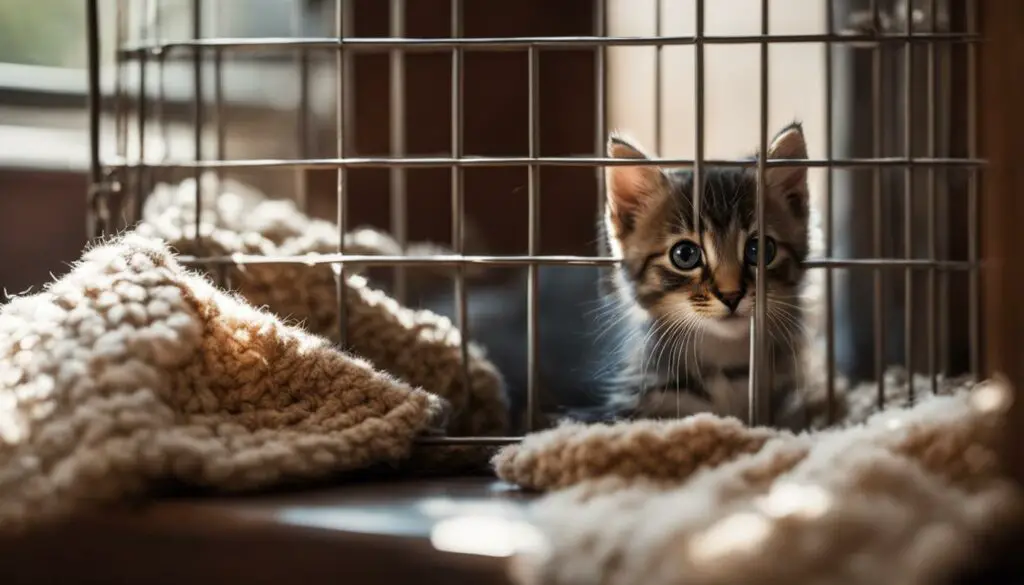When it comes to kitten care, one question that often arises is how long can you keep a kitten in a cage? Understanding the factors that go into determining the duration of confinement is important to ensure the well-being and mental health of your furry friend.
Confinement, whether in a cage or another confined space, can serve various purposes such as kitten training, managing their behavior, or providing a safe environment during certain situations. However, it is crucial to strike a balance between confinement and allowing them to explore and exercise.
The length of time a kitten can stay in a cage depends on several factors, including their age, health, and the availability of essential necessities like food, water, and a litter box. While short periods of confinement can be tolerable, keeping a kitten in a crate for excessive periods can lead to anxiety and aggression.
Key Takeaways:
- Confined spaces can be useful for kitten training and managing their behavior, but it’s important to prioritize their well-being.
- The duration of confinement depends on factors like age, health, and access to necessities like food, water, and a litter box.
- Excessive periods of confinement can lead to anxiety and aggression in kittens, so it’s important to find a balance.
- Alternatives to crate confinement, such as confining them to a small room, can provide a comfortable and safe environment.
- Regular playtime and monitoring of their behavior are essential for a happy and healthy kitten.
Getting Started with Crate Training
When it comes to crate training, it’s important to introduce your kitten to the crate gradually. Start by leaving the crate door open and allowing your kitten to explore the crate on their own terms. You can place treats or toys inside the crate to encourage positive associations. Over time, as your kitten becomes more comfortable with the crate, you can start closing the door for short periods while they nap or rest.
During the initial stages of crate training, it’s crucial to make the crate a positive and comfortable space for your kitten. Ensure that the crate is well-ventilated and lined with soft bedding. You can also place an article of your clothing inside the crate to provide a familiar scent. This will help your kitten feel safe and secure in their new environment.
| Benefits of Gradual Acclimation to the Crate | Nap Time in the Crate |
|---|---|
|
|
Remember, crate training should always be done with patience and positive reinforcement. Never use the crate as a form of punishment, as this can create negative associations and hinder the training process. By gradually acclimating your kitten to the crate and allowing them to associate it with comfort and relaxation, you can lay the foundation for successful crate training.

Regular Crating Guidelines
When it comes to regularly crating a kitten, it is important to consider their mental health and natural behavior. Cats are naturally active animals that require space to roam and explore. Crating a kitten for extended periods can lead to stress, anxiety, and behavioral issues. To ensure the well-being of your kitten, it is recommended not to exceed six hours of confinement at a time.
During the time your kitten is crated, it is essential to provide them with necessary provisions. These include access to a litter box, fresh water, and, if necessary, food. This will help ensure their physical comfort and minimize any potential stress or discomfort arising from being confined.
Remember that every kitten is unique, and their tolerance for crating may vary. Some kittens may become restless or agitated after a shorter period, while others may be more comfortable and relaxed. It is crucial to observe your kitten’s behavior and adjust the crating duration accordingly. If you have concerns or questions about regular crating, consulting with a veterinarian or a professional animal behaviorist can provide valuable guidance and support.
Creating a Comfortable Crating Environment
To make the crating experience as comfortable as possible for your kitten, consider the following:
- Use a crate that is spacious enough for your kitten to move around comfortably but not too large that they may feel overwhelmed.
- Line the crate with a soft blanket or cushion to provide a cozy sleeping area.
- Offer toys, scratching posts, or interactive puzzles to keep your kitten mentally stimulated and entertained while crated.
- Position the crate in a quiet area of your home where your kitten can feel secure and undisturbed.
By following regular crating guidelines and creating a comfortable environment, you can ensure the well-being and mental health of your kitten while addressing the need for temporary confinement.
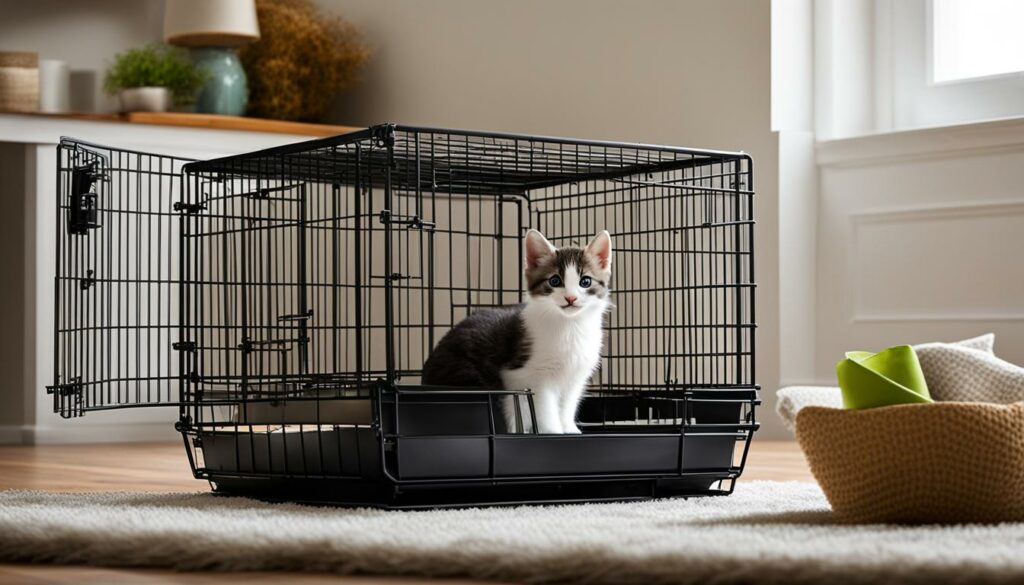
Prolonged Confinement: Managing Crating for Longer Durations
There may be circumstances where extended crating is necessary for a kitten, such as during illness or recovery from an injury. In these situations, it is crucial to follow the guidance of a veterinarian on the appropriate duration of confinement. They will consider the specific needs of the kitten and ensure that their health and well-being are prioritized. Whether it’s post-surgery or managing a chronic condition, the veterinarian will provide expert advice on how long the kitten should remain in the crate.
Additionally, emergencies or situations involving feral kittens may require temporary crating for a longer period. While it is not ideal for kittens to be confined for extended periods, these instances may be unavoidable. To help alleviate stress, it is recommended to provide distractions inside the crate, such as toys, and position the crate in a location where the kitten can see you when you are home. This visibility can provide a sense of comfort and security for the kitten even during longer crate stays.
| Scenario | Duration of Confinement | Additional Considerations |
|---|---|---|
| Illness or Injury | As recommended by a veterinarian | Follow veterinary guidance for proper care and monitoring |
| Emergency | As long as necessary | Provide visual and auditory reassurance to reduce stress |
| Feral Kittens | Temporary confinement until they can be assessed and rehomed | Assistance from a professional or animal rescue organization may be required |
Remember, prolonged confinement should always be the last resort and only undertaken when absolutely necessary. It is essential to prioritize the well-being of the kitten and seek professional advice to ensure their physical and mental health during these longer crate stays. Regular monitoring, providing necessary care, and creating a comforting environment can help minimize the potential negative impact of extended crating.
Crating Alternatives
While crating can be an effective strategy for confining a kitten, it is not the only option available. If you prefer to avoid prolonged crating or your kitten seems resistant to being in a crate, there are alternatives to consider. Two popular alternatives to crating are small room confinement and bathroom confinement. These options provide a restricted but comfortable area for the kitten to stay in, allowing them some freedom of movement while ensuring their safety.
Small Room Confinement
Confining the kitten to a small room is a viable alternative to crating. This can be a bedroom, a designated kitten room, or any other enclosed space where the kitten can have some freedom to move around. It is important to ensure that the room is kitten-proofed by removing any potential hazards or fragile items. Providing the kitten with their essential necessities like food, water, a litter box, and toys in this confined space will help them feel comfortable and secure.
Bathroom Confinement
Another alternative to crating is bathroom confinement. This involves placing the kitten in a bathroom that is safe, clean, and well-ventilated. Make sure to remove any harmful substances or objects that the kitten may access. Place a litter box, food, water, and toys in the bathroom to provide the necessary essentials. The confined space of the bathroom gives the kitten a sense of security while still allowing them some space to move around.
When considering these alternatives, it is important to assess your kitten’s individual needs and behavior. Some kittens may prefer the coziness of a crate, while others may feel more comfortable in a larger confined area. Experiment with different options and observe how your kitten responds to each setting. Ultimately, the goal is to provide a safe and comfortable space for your kitten to rest and feel secure.
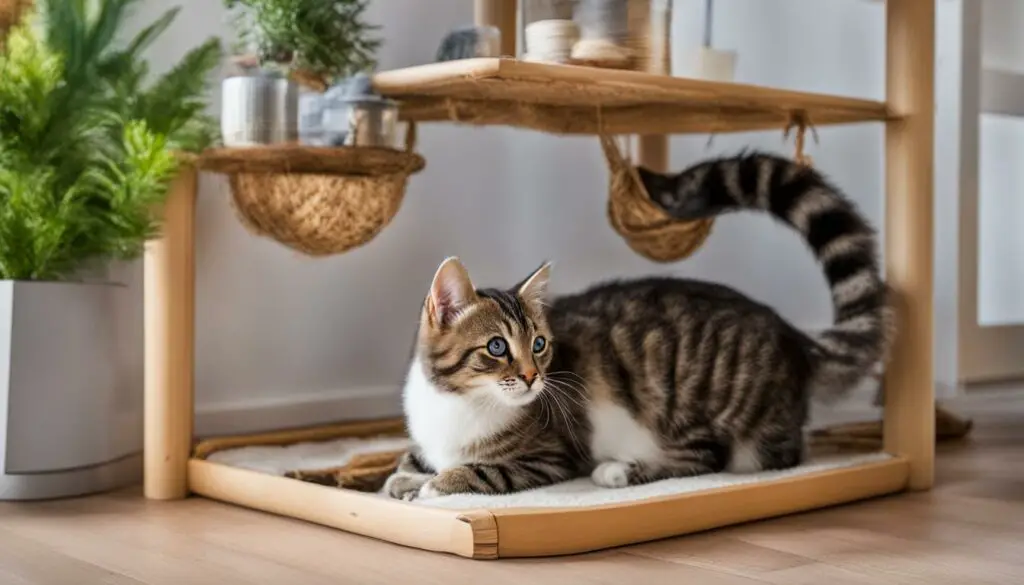
Professional Cat Care Equipment
When it comes to providing the best care for your feline companions, having the right equipment is essential. That’s where Direct Animal comes in. We specialize in offering a wide range of professional cat care equipment, including top-of-the-line cat condos. Our products are specifically designed to meet the needs of animal facilities and contribute to the overall well-being of cats.
Our professional cat condos are built with durability, hygiene, and comfort in mind. They are made from high-quality materials that are easy to clean and maintain, ensuring a safe and sanitary environment for your furry friends. The thoughtful design of these cat condos provides ample space for cats to move around, play, and relax.
| Benefits of our professional cat condos: | Key Features: |
|---|---|
|
|
Whether you run an animal shelter, veterinary clinic, or boarding facility, our professional cat condos are the ideal choice for providing a comfortable and secure environment for cats in your care. With Direct Animal, you can trust that you are investing in high-quality equipment that will withstand the test of time and provide the utmost comfort for cats.
For more information about our professional cat care equipment, including our cat condos, please contact Direct Animal. We are committed to helping you create a safe and enriching space for your feline friends.

Can You Put a Kitten in a Cage at Night?
When it comes to overnight crating, many kitten owners wonder if it is safe and beneficial for their furry friends. While it is generally acceptable to put a kitten in a cage at night, there are some safety concerns and considerations to keep in mind to ensure the kitten’s well-being. Overnight crating can serve as a way to provide a safe and controlled environment for young kittens, especially if they are not yet familiar with their new surroundings.
However, it is important to limit the amount of time a kitten spends in the crate during the day to prevent excessive confinement. Prolonged periods of crating can lead to anxiety and behavioral issues. It is crucial to prioritize the kitten’s safety and mental health by providing them with opportunities for play, exercise, and socialization outside of the crate.
Remember to always monitor the kitten while they are crated at night and ensure that they have access to the essential necessities such as food, water, and a comfortable sleeping area. Balancing the benefits of overnight crating with the overall well-being of the kitten is key to creating a positive and nurturing environment.
“Overnight crating can be a helpful tool for ensuring the kitten’s safety and preventing them from freely roaming around the house at night. However, it is essential to limit the duration of confinement, provide necessary provisions, and take into account the individual kitten’s needs and behavior.” – Kitten Care Expert
By considering the safety concerns, prioritizing kitten safety, and maintaining their overall well-being, overnight crating can be a viable option for providing a secure sleeping arrangement for your furry friend.

Table: Pros and Cons of Overnight Crating
| Advantages | Disadvantages |
|---|---|
|
|
Advantages of Overnight Crating
Crating a kitten at night can offer several advantages that contribute to their well-being and a peaceful sleep routine. Here are some benefits to consider:
- Better sleep routine: Overnight crating can help establish a consistent sleep schedule for your kitten. By providing a designated space for them to rest, they can develop a routine that aligns with your own sleep patterns. This ensures that both you and your kitten can enjoy uninterrupted sleep throughout the night.
- Prevent morning disruptions: Crating your kitten at night helps prevent early morning disturbances. Kittens are naturally curious and energetic, and without confinement, they may roam around the house, potentially causing trouble or accidents. Crating provides a safe and controlled environment, ensuring that your morning begins smoothly and without any unexpected surprises.
- Avoiding trouble and accidents: During the night, kittens may engage in playful behavior or explore areas that pose risks to their safety. Crating them helps avoid potential trouble or accidents by keeping them in a secure space. This promotes a sense of security and minimizes the likelihood of any accidents or injuries occurring while you are asleep.
- Safe and comfortable space: Crates provide a cozy and safe space for your kitten to sleep. They can retreat to their crate and feel secure, especially if it is furnished with soft bedding and familiar scents. This creates a comfortable sleeping environment that promotes relaxation and a restful night for your kitten.
By considering these advantages, you can make an informed decision about whether overnight crating is the right choice for your kitten’s sleep routine. Keep in mind that every kitten is unique, and it’s essential to assess their individual needs and behaviors when determining the most suitable sleeping arrangement.
| Advantages of Overnight Crating |
|---|
| Better sleep routine |
| Prevent morning disruptions |
| Avoiding trouble and accidents |
| Safe and comfortable space |
Quote:
“Crating at night provides a safe and controlled environment, ensuring a peaceful sleep routine for both the kitten and the owner.”– Kitten Care Expert
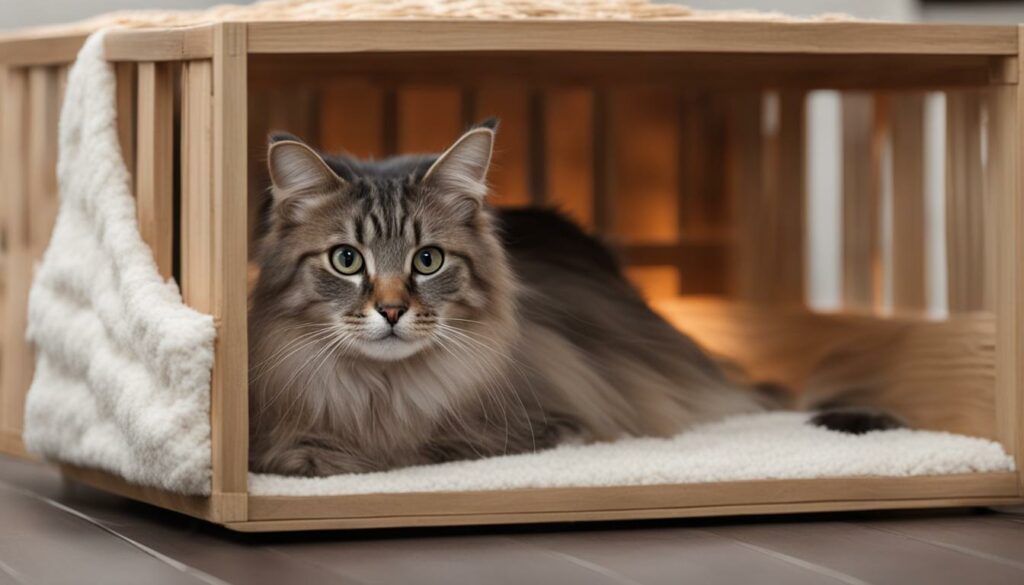
Considering the advantages of overnight crating, it is important to evaluate your kitten’s specific needs and behaviors. While crating can provide a better sleep routine, prevent disruptions, and offer a safe space, it’s essential to create a balanced approach that takes into account your kitten’s overall well-being and individual preferences.
Disadvantages of Overnight Crating
While overnight crating can have its benefits, there are also potential disadvantages to consider when deciding whether to crate your kitten at night. Here are some factors to keep in mind:
Excessive Meowing
One common challenge with overnight crating is excessive meowing. Some kittens may express their displeasure with being confined by vocalizing loudly throughout the night. This can be a source of disturbance for both the kitten and the owner, disrupting sleep and causing stress.
Limited Monitoring
Another disadvantage of overnight crating is the limited ability to closely monitor your kitten. When they are in the crate, you may not have a clear view of their behavior, comfort, or well-being. This can make it more difficult to address any potential issues or attend to their needs promptly.
Resistance to Confinement
Some kittens may develop resistance to confinement if they are crated consistently at night. This can manifest as increased anxiety, restlessness, or even aggression. It’s important to pay attention to your kitten’s response to being crated and make adjustments if necessary.
Potential Behavior Problems
In some cases, kittens that are crated overnight may develop behavior problems. This can include increased aggression, destructive chewing, or excessive grooming. These behaviors could be a result of stress or frustration associated with being confined for extended periods.
While overnight crating may be suitable for some kittens, it’s important to weigh these potential disadvantages against the benefits. Every kitten is unique, and their individual needs and temperament should guide the decision-making process. Consulting with a veterinarian can provide valuable insights and guidance to ensure the well-being and happiness of your kitten.
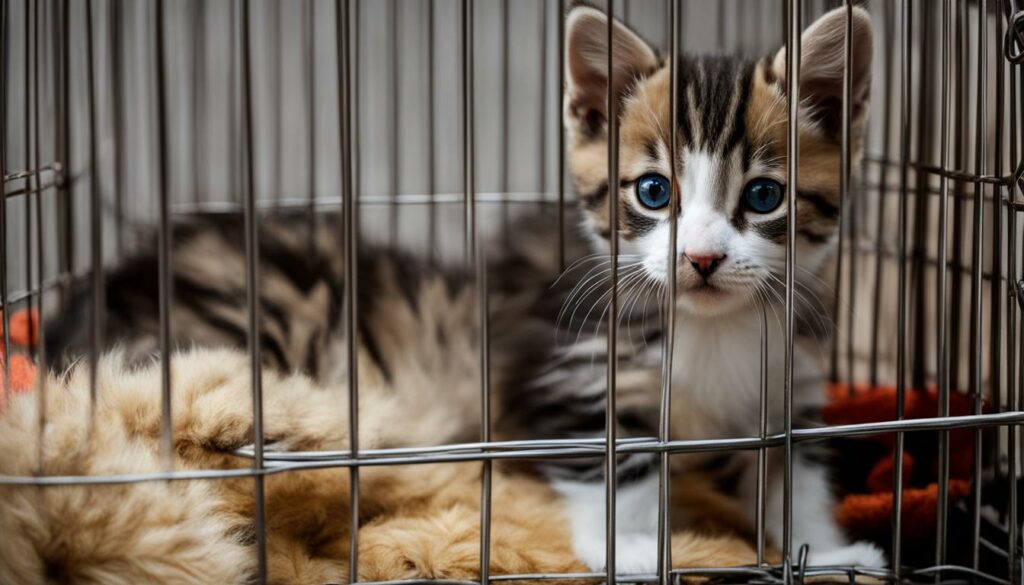
Sleeping Arrangements for Your Kitten at Night
When it comes to deciding where your kitten should sleep at night, it’s important to prioritize their safety and provide them with a comfortable and secure environment. One of the recommended options is confining your kitten to a small, enclosed area such as a bathroom or laundry room. This allows them to have access to their litter box and essentials while limiting their movements to ensure their well-being.
In this confined area, make sure to remove any potential hazards that could harm your kitten. Keep cleaning supplies, medications, and small objects out of their reach. Create a cozy sleeping space with a comfortable bed or blanket where they can rest undisturbed. Additionally, ensure that the room is properly ventilated and at a temperature that is comfortable for your kitten.
By confining your kitten to a small room at night, you can provide them with a sense of security and prevent any potential accidents or mischief while you sleep. Remember to maintain a consistent routine and gradually introduce them to their sleeping area to help them feel more comfortable and at ease.
| Benefits of Confined Sleeping Areas for Kittens | Safety Precautions |
|---|---|
|
|
Remember, each kitten is unique, and it’s important to consider their individual needs and behavior when determining their sleeping arrangements. Some kittens may prefer to sleep in a different area, such as their own bed or a specific spot in your room. Observe their behavior and adjust their sleeping arrangements accordingly to ensure their comfort and well-being.

Creating a safe and comfortable sleeping environment for your kitten at night is essential for their overall happiness and well-being. By providing them with a confined area that meets their needs, you can ensure they have a peaceful and restful night’s sleep.
Additional Considerations
When it comes to crating or confining a kitten, there are a few additional considerations to keep in mind. Ensuring a safe and kitten-proofed environment is crucial to prevent any potential hazards. Kitten-proofing involves securing loose wires, removing toxic plants, and keeping small objects out of reach. Creating a designated play area with interactive toys can help reduce boredom and excess energy, making the kitten more likely to sleep peacefully at night. Additionally, providing a scratching post and vertical spaces can help satisfy the kitten’s natural instincts.
Another consideration is the possibility of having a second cat as a companion for the kitten. Introducing a playmate can provide social interaction, play opportunities, and companionship for the kitten, especially if they spend extended periods of time in confinement. However, it is important to properly introduce the cats and monitor their interactions to ensure compatibility and a harmonious living environment.
Observing and understanding behavioral cues is also essential when crating a kitten. Pay attention to the kitten’s body language and vocalizations to assess their comfort level and well-being. If a kitten shows signs of distress or anxiety, it may be necessary to adjust the confinement arrangements or seek professional advice.
Table: Kitten-Proofing Checklist
| Area | Kitten-Proofing Measures |
|---|---|
| Kitchen | Secure cabinets, remove hazardous food items |
| Living Room | Cover electrical cords, secure blinds and curtains |
| Bathroom | Keep toilet lids closed, store medications safely |
| Bedroom | Secure loose wires and cables, cover outlets |
| Outdoor Areas | Fence off potentially dangerous areas, remove toxic plants |
In summary, kitten-proofing the environment, providing playtime and companionship, and being attentive to behavioral cues are important additional considerations when crating or confining a kitten. By ensuring a safe and stimulating environment, the kitten can have a positive confinement experience while maintaining their overall well-being and happiness.
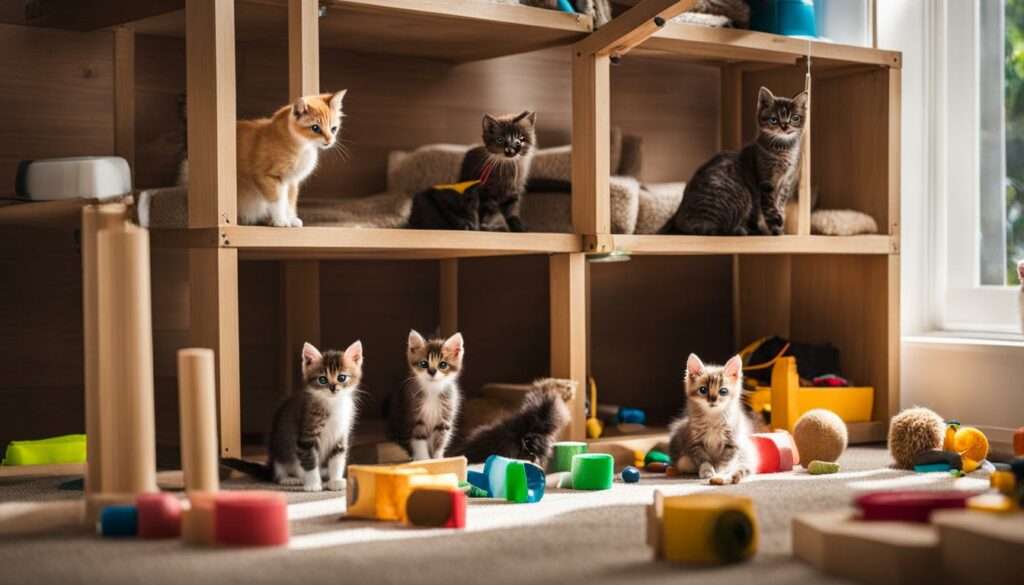
Final Thoughts on Crating a Kitten at Night
When it comes to crating a kitten at night, it is important to consider their behavior, training, and overall well-being. Crate training can be a useful tool in establishing a better sleep routine and preventing morning disruptions. However, it is crucial to ensure that the duration of confinement is reasonable and that the kitten has access to essential necessities like food, water, and a litter box. Alternatives to crating, such as confining the kitten to a small room, can also provide a safe and comfortable sleeping arrangement.
Crate training can positively impact a kitten’s behavior and their ability to feel secure in their surroundings. It allows them to have a designated space that is their own, where they can feel safe and protected. The crate can also serve as a helpful tool in potty training, as kittens are naturally inclined to keep their sleeping area clean. However, it is important to monitor the kitten’s response to crating and make adjustments as necessary. Each kitten is unique, and their comfort level with confinement may vary.
While crating a kitten at night can have numerous benefits, it is essential to remember that their well-being should always come first. Monitoring their behavior and observing any signs of stress or discomfort is crucial. Additionally, providing plenty of playtime and mental stimulation during the day can help ensure that the kitten is tired and ready for a peaceful night’s sleep. Ultimately, the goal is to create a sleeping arrangement that promotes the kitten’s overall well-being and supports their healthy development.
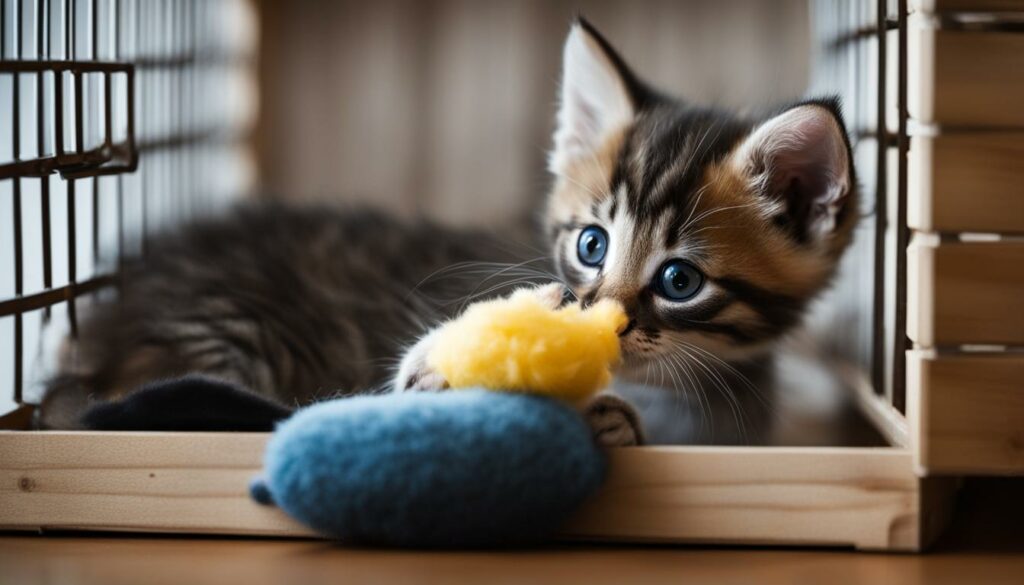
The Importance of Consistency and Patience
When embarking on crate training or any form of confinement for a kitten, it is essential to approach it with consistency and patience. Consistency in terms of establishing a routine and setting clear boundaries will help the kitten understand what is expected of them. Patience is also key, as kittens may initially resist being confined or exhibit behaviors such as excessive meowing. By remaining patient and providing positive reinforcement, you can help the kitten adapt to their crate and see it as a safe and comfortable space.
Considering Professional Consultation
If you are unsure about crate training or have concerns about your kitten’s behavior or well-being, it may be beneficial to seek professional consultation from a veterinarian or animal behaviorist. They can provide personalized guidance based on your kitten’s specific needs and help address any challenges you may be facing. Remember, every kitten is unique, and what works for one may not work for another. Professional advice can ensure that you provide the best possible care for your furry friend.
Conclusion
When it comes to caring for a kitten, proper confinement is crucial for their well-being and development. The duration that you can keep a kitten in a cage depends on various factors, such as their age, health, and the purpose of confinement. It is important to prioritize their mental health and avoid excessive periods of crate confinement, as this can lead to anxiety and aggression.
If you choose to crate your kitten at night, it can help establish a better sleep routine and prevent morning disruptions. However, it is important to limit the amount of time they spend in the crate during the day and provide alternatives if possible. Confining them to a small, kitten-proofed room or bathroom can provide a safe and comfortable sleeping arrangement while allowing them access to their essential necessities.
Remember to consider your kitten’s individual needs and behavior when determining the appropriate approach to confinement. Provide ample playtime, monitor their responses, and establish a nighttime routine to signal winding down for bed. By balancing confinement, training, and overall well-being, you can ensure a positive development experience for your kitten.
So, how long can you keep a kitten in a cage? The duration should be reasonable and considerate of their needs. Prioritize their care, provide a safe sleeping arrangement, and remember that proper kitten care involves finding the right balance for their overall well-being.
FAQ
How long can you keep a kitten in a cage?
The duration that you can keep a kitten in a cage depends on various factors, such as the purpose of confinement, the age and health of the kitten, and the availability of essential necessities like food, water, and a litter box.
What is the recommended approach for crate training a kitten?
It is recommended to gradually introduce a kitten to the crate by leaving them inside for short periods with the door open. As they become more comfortable, you can increase the duration of time they spend in the crate.
How long should regular crating periods be?
It is advisable not to exceed six hours of confinement at a time to maintain the kitten’s mental health and prevent anxiety and aggression.
Are there situations when longer crate stays are necessary?
Yes, during illness or recovery from an injury, it is important to follow the guidance of a veterinarian on the appropriate duration of confinement. In emergencies or when dealing with feral kittens, temporary crate stays may also be necessary.
What are the alternatives to crating a kitten?
Instead of using a crate, you can confine the kitten to a small room with closed doors or a bathroom with a litter box.
Where can I find professional cat care equipment?
Direct Animal offers a range of ergonomic, hygienic, and affordable cat care equipment, including professional cat condos.
Is it acceptable to put a kitten in a cage at night?
Yes, it is generally acceptable to crate a kitten at night, especially when they are eight weeks old or younger. This is to ensure their safety and prevent them from freely roaming around the house.
What are the advantages of overnight crating for kittens?
Overnight crating can help establish a better sleep routine for the kitten, prevent disruptions, and provide a safe space for them to rest.
Are there any disadvantages to overnight crating?
Some kittens may meow throughout the night and may develop resistance to confinement, potentially leading to behavioral problems. Being away from the kitten while crated may also limit your ability to monitor their well-being.
Where should a kitten sleep at night?
It is ideal for a kitten to sleep in a small, confined area such as a bathroom or laundry room, ensuring their safety and providing a comfortable sleeping environment.
What are some additional considerations when crating a kitten?
Kitten-proof the designated area, provide ample playtime during the day, and consider getting a second cat for companionship. Establishing a nighttime routine can also help signal bedtime for the kitten.
How should I approach crating a kitten at night?
Crating a kitten at night should be approached with careful consideration of their individual needs and behavior. Balancing confinement, training, and overall well-being is essential.

